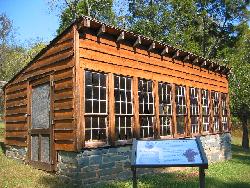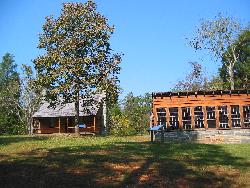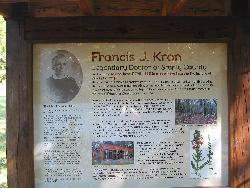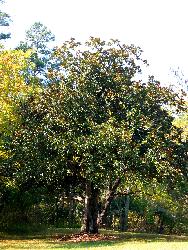
Germination!
06/11/2007 @ 0900
|
| |
| The
first seeds have germinated, which is
always good for spirit boosting. The
usual suspects were the first: the
honeylocust, and the wisteria. These
seeds are very reliable, and I always
recommend them to anyone who is planting
seeds with kids. The honey locust
germinates within 10 days, and the
wisteria within 2 weeks. I expect the
ginkgo and catalpa seeds next.
Actually, checking the seeds this
afternoon, I see that the crape myrtle
seeds are germinating, tiny but there.
First time for these guys.
|
|
Tree Planting
Day 2
05/31/2007 @ 0900
|
| |
The
fourth of seeds included (Tray D):
-
Ginkgo - I collected these seeds
from my neighbors house; he usually
rakes them up, but I snagged a few.
I planted these last year, and I had
very good results with germination.
These seeds really stink, and the
guys at work make me work with them
outside.
-
Northern
Catalpa - I have to grow some of
these; they are so easy to germinate
and always make me think I know what
I am doing.
-
Green Castor Bean - This is an
annual plant, not a tree, and I
ordered the seeds rather than
collect then, but I saw a photo of
the seeds and the plant and they
looked so interesting I had to try
them.
Here is the diagram of Tray
D. Be sure to see the page for
each individual seed type to learn more. |
|
Tree Planting
Day 1
05/31/2007 @ 0900
|
| |
| This
year I planted very late, on the
30th of May, due to several reasons,
including house issues, other interests,
and a little laziness. I don't
know what will happen, but it is already
hot here in Delaware, over 90 today, so
there should be no problems with
germination. As usual, I planted
in the standard seed trays, 6 by 12,
that you can buy at any home store. I
didn't use the
"greenhouse" lids, just set
the trays in my planters and then left
town. I planted 3 trays of seeds this
year, so far.
The first tray of seeds included (Tray
A):
-
Katsura - I found a nice tree at
Rockwood State Park near my house,
in their walled garden area. I
snagged some seeds last fall, and
just held them in a plastic bag,
dry, over the winter. All the little
pods had split open and ejected the
seeds.
-
Zelkova - There are a bunch of
these planted around a chemical
plant near my plant. I just happened
to be walking by last fall and
spotted these very tiny seeds
hanging within reach. I just held
them over the winter in a dry ziploc
bag. This is a first time for these
guys for me.
-
Siberian Elm - I spotted this
tree near my house last fall, with
the seeds still hanging on. Most
elms go to seed early in the season,
but these last into the winter. I
held the seeds dry in a plastic bag.
-
Crape Myrtle - I found these
while walking in Brandywine Park
next to the river last fall. I held
the seeds in a ziploc bag over the
winter, and they split open easily
to release the individual seeds.
-
Poncirus - Hardy Orange - I
manage to germinate and grow some of
these each year, but they do
not overwinter. Maybe they need to
be brought indoors until they get
larger.
-
Hophornbeam
- I managed to grow 3 of these trees
from seed a few years ago, and 2 are
still alive. They are about a foot
high, and very pretty. I discovered
a new source for seeds last year, in
a local park, and gathered a handful
of seed pods. These particular seeds
I removed from the pods and held
over the winter in a plastic bag.
Tray B:
-
American beech - I collected
these seeds from my backyard last
fall.
-
Goldenrain
- not to be confused with "Goldenchain"
trees. These have very pretty pods
in the fall. I have planted several
here at my plant, and for some
reason they seem to grow well in the
mix of clay and old brick here.
-
Holly - from a tree near my house
I pass while walking to Home
Depot.
-
Magnolia - from a "bigleaf"
tree growing in a county park near
my house. Macrophylla is the
species name. The leaves and flowers
from these trees are truly
"big" - the leaves are
over a foot long. I held the seed
pod in a ziploc bag over the winter,
and it was pretty rotten and soft by
now. I put on some latex gloves and
worked through the pod to find the
seeds.
-
Wisteria - I collected from a
great trellis wisteria in a state
park near my house. I just held the
pods in a bag until the spring, then
gave the pods a twist with my hands
to get them to pop open. These seeds
are easy: they need just to be
stuffed into the ground to
germinate.
-
Osage-Orange
- I feel a little silly planting
these guys, since they almost always
germinate, and aren't much of a
challenge. However, they are about
the only tree that seems to grow in
the clay-we-call-soil here at my
plant, and I need to finish a hedge
around the area.
Tray C:
-
Persimmon - the
"historic" seeds I
collected two years ago while on a
camping trip through North Carolina.
I visited Morrow State Park, which
contains the homestead of a Dr.
Francis J Kron, who was the main
country doctor for those parts in
the mid-1800s. He was quite a
horticulturist, and had many
"collectable" trees on his
property. I gathered some dogwood,
persimmon, and magnolia seeds while
there. Persimmons used to be used
for golf club heads
("woods") as the wood is
very strong, dense, hard, and
fine-grained. Now I guess
everyone uses the titanium heads,
but if you get a chance to see an
old set of clubs, check out the
wood. It is very beautiful. The
seeds had been held in a sealed
ziploc bag since I collected them,
and had not rotted nor molded. Last
year none of them germinated. I
scored the seeds gently with a
hacksaw this year before planting.




-
Mystery - what would a growing
season be without a mystery tree?
This is a double mystery, because I
can't even remember where I found
them. I found a plastic bag of dry
pea-size seeds; they might be
linden, since I remember collecting
from a littleleaf linden last fall,
but I don't know.
-
Crabapple - I really have no
interest in growing crabapples, but
I was collecting in my neighborhood
and saw some of these fruits still
on the trees in the winter. Anything
that birds and animals might use for
food in the winter is cool, so let's
see what happens.
-
Hornbeam - American
Hornbeam (carpinus carolinia)
- these seeds I collected from
Brandywine Park while on a walk. I
just held these dry in a ziploc over
the winter.
-
Pink Shrub - I found some little
red seeds, looking somewhat like
dogwood seeds, on a pink shrub I saw
while hiking along the Brandywine
river last fall. This whole section
of woods was full of these
pink-leaved shrubs, which were at
most about 10 feet tall.
-
Chinese Scholartree - I like the
looks of these trees a lot, and the
trees are reputed to be very
"street" smart - they
resist pollution, lack of water,
dogs, and salt. I have a couple
growing here at my plant in clay and
stone, and they are doing well. The
survive the dry weather in the
summer here with only minimal leaf
loss, while the honey locusts will
drop all their leaves.
-
Kentucky
Coffeetree - I love collecting
and growing these seeds. They are
about the toughest material in
nature - you need a hacksaw to
scratch them. There are some large
trees in a state park near my house
that I visit each fall and winter.
Early in the fall it is good sport
to try to knock them off the tree,
but by January most of them are on
the ground. These need to be cut
about 1/16" deep with a hacksaw
to germinate.
-
Honeylocust - I collected these
seeds last fall from my
favorite "wild" tree
with lots of spines; last year was a
seed year, since the tree
seems to produce seed pods only
every 2 years. As usual, I
just made a little cut into the seed
hull with a hacksaw, more like a
scratch. And lots of thorns on these
guys - as many as osage orange.
Here is the diagram of the Trays
A & B and Tray
C. Be sure to see the page for
each individual seed type to learn more. |
|
Pepper
Planting
Day
05/19/2007 @ 0900
|
| |
| The
weather is warm, no danger of frost, and
my peppers want to get into the ground.
I planted in the 4' x 4' planters I have
used in the past. I covered 3 of the
planters with black landscape fabric to
try and keep the weeds down. I put 5
plants in each planter, which isn't
quite enough room, but this year I plan
to use a tomato cage on the center
plant.
Here is the diagram of the planters. |
|
Pepper Seed
Starting
Day
03/14/2007 @ 0900
|
| |
| This
year I got my pepper seeds started right
on time, just before St. Patricks Day.
With the climate seeming to warm, and
the USDA hardiness zones moving, maybe I
could start a little sooner, but I am
used to this date. As usual, I
plant in the standard seed trays, 6 by
12, that you can buy at any home store.
I use the "greenhouse"
lids to hold in moisture until the
seedlings get too big. I use my homemade
planting light, with two flurorescent
bulbs for light, and a single
incandescent bulb for heat. I planted 2
trays of seeds this year.
Note: I get most of my seeds from
Pepper Joe's (www.pepperjoe.com).
I have had good luck with germination
using their seeds, they have a great
variety of seeds, and I recommend them.
I do not receive anything from them for
this endorsement.
The types of peppers and their
descriptions from the seller in
blue quotes:
-
Long Red Slim - no
description, but this one is like an
Italian red pepper, long and thin.
When dried, great for frying with
potatoes for a winter warmer.
-
Thai Sun - "Perfect
pepper for apartments and small
Gardens. The miniature plant only
grows ten to twelve inches high and
about one to one and a half feet
wide. The one inch peppers grow
facing the sun. One plant has
literally hundreds of these
fireballs. This little devil packs a
big wallop. The leaves are tiny so
the plant is almost all peppers. It
is easily grown in containers put on
a porch, patio or deck. Anyone,
anywhere can enjoy plenty of hot
peppers with the Thai sun pepper.
They ripen early and produce all
season long. Each pod has a few
scarce seeds."
-
Las Cruces Chile - "This
new and awesome Hot Pepper comes
from Las Cruces, New Mexico... known
as the world headquarters for Chile
Peppers. It is the Mecca for Hot
Pepper research and development.
This is a great Pepper and highly
recommended by Pepper Joe. It has a
Jalapeno shape...but broader and
more blunt with a thick skin and
fabulous, spicy taste. It has tested
well and we proudly introduce it to
you."
-
Jalapeno - "The
classic jalapeno is fleshy and
irreplacable for stuffing. I stuff
mine with ham and cheese and then
pickle. Smoked chipotle peppers are
made from this dependable favorite.
Good for cool climates."
-
Hot Caribbean - "Mega-hot
and bursting with flavor. You asked
for it and here it is. The heat
generated by this wrinkled
lantern-shaped chile is absolutely
ATOMIC!"
-
Firecracker - "Small
spicy chile is big on taste and
yield. Bushy compact plant tops a
hundred hot peppers. Perfect for
container gardening…then bring
indoors to over-winter and get a big
jump on next years production."
-
Bolivian Rainbow - "TOTALLY
AWESOME. Tear-drop shaped hot
peppers with a spicy taste. They
turn from purple to yellow to orange
and then red. The everbearing plant
has green leaves with purple veins.
I counted over 300 peppers on the
plant at one time. This gorgeous
pepper bears early and continues
throughout the season."
-
Crimson Torpedo - "The
reliable peppers to grow and enjoy
are still in the Cayenne family.
This 2 1/2 inch long pepper is
loaded with flavor. It is a
vivacious red in color and is
delicious fried in garlic and olive
oil and used for a topping...on
pasta, sandwiches, pizza, just about
any dish you want to add zing to.
Extremely dependable."
-
Fluorescent Purple - "Mother
nature got fancy when she created
this incredible work of art. The
leaves on this plant are sensational
fluorescent purple and white. It is
absolutely the most breathtaking
foliage I have ever seen. But there
is more. The florescent purple and
white foliage is surrounded by
little hot dynamos that turn from
green, to purple, then to red when
ripe. I recommend this pepper for
gardeners who have difficulty
starting seed indoors. Easy to
germinate, transplant and
grow."
-
Charleston Hot - "MOST
SOUGHT AFTER PEPPER IN THE UNITED
STATES... After 12 years of
developing, plant pathologist Phil
Dukes released the Charleston and
received over 50,000 requests for
seeds. In a copy of "Science
Update" the ARS researchers
pleaded "No More Requests
Please". The Charleston
performed well in all field tests
for over 5 years.
MORE ABOUT THE CHARLESTON... The
charleston was selected our of
hundreds of strains. The plants were
kept in isolation for pure seed.
"Home Gardeners will like this
variety because it doesn't take up
as much space as other Cayenne
varieties" says Phil Dukes. 'It
only grows about 15" high and
produces about two pounds of fresh
peppers per plant. The rainbow
colors start out yellow green, then
golden yellow, bright orange than to
deep red when it ripens. It is about
20 times hotter than the typical
Cayenne (about 70,000 to 80,000
Scoville Units) and can be grown
anywhere in the USA'."
I grew these from seeds I saved from
last year - we'll see if they grow
true, or hybridize.
-
Ancho - "This
heart-shaped chile is used to make
chile rellanos and is often dried
& ground into chile powder. It's
called Poblano when used fresh,
Ancho when dried. Highly
requested."
I grew a bunch of these a few years
ago and dried them for use in soups.
Very flavorful.
Here is the diagram of the Trays
A &B. |
|
Seed
Collecting for 2007
01/04/2007 @ 0900
|
| |
|
My seed collecting started last
fall, with help from friends and
readers who either sent me seeds, or
directed me to a new tree. The
lineup for this year, with the trees I'm
trying for the first time marked:
sweetgum
ginkgo
Kentucky coffeetree
sawtooth oak
Eastern redbud
osage orange
poncirus trifoliata (hardy orange)
hophornbeam
wisteria
Northern catalpa
Chinese scholartree
magnolia (bigleaf, umbrella, and
star(?))
katsura
goldenrain tree
|
|
Welcome
to 2007!
01/01/2007 @ 1000
|
| |
|
Welcome to the growing season of
2007.
Things have changed around here
in just the past few weeks. All the land
around our plant has been sold to a
group who wants to build either
commercial units, or possibly a casino.
All the land has been cleared, and they
are starting to fill. I hope we aren't
flooded out in the first big rain. Plus,
some of my planting boxes are on their
property, so hopefully they won't do any
surveying and fencing and force me to
move.
This year looks to be interesting,
with some new seeds and another try at
some old favorites.
I had pretty good luck with my hops
last year, with Cascade and Chinook
yielding enough for a batch of beer.
This year, with the rhizomes better
established, I hope to get Centennial
and Glacier as well.
And hot peppers: as usual, I will be
growing way too many hot peppers. I
smoked some last year, which I have been
using for sauces and soups, and I hope
to do more this year. My basement is
full of hanging dried pepper plants.
|
|
|
|
|
 Welcome to "The 2007 Growing Season," the story
of the 2007 Trees from Seeds tree garden. This column will
provide you with a regular update on the status of this
year's crop of tree seedlings.
Welcome to "The 2007 Growing Season," the story
of the 2007 Trees from Seeds tree garden. This column will
provide you with a regular update on the status of this
year's crop of tree seedlings.
|
|
| |
|
Check out my RSS feed for your newsreader:
|
|